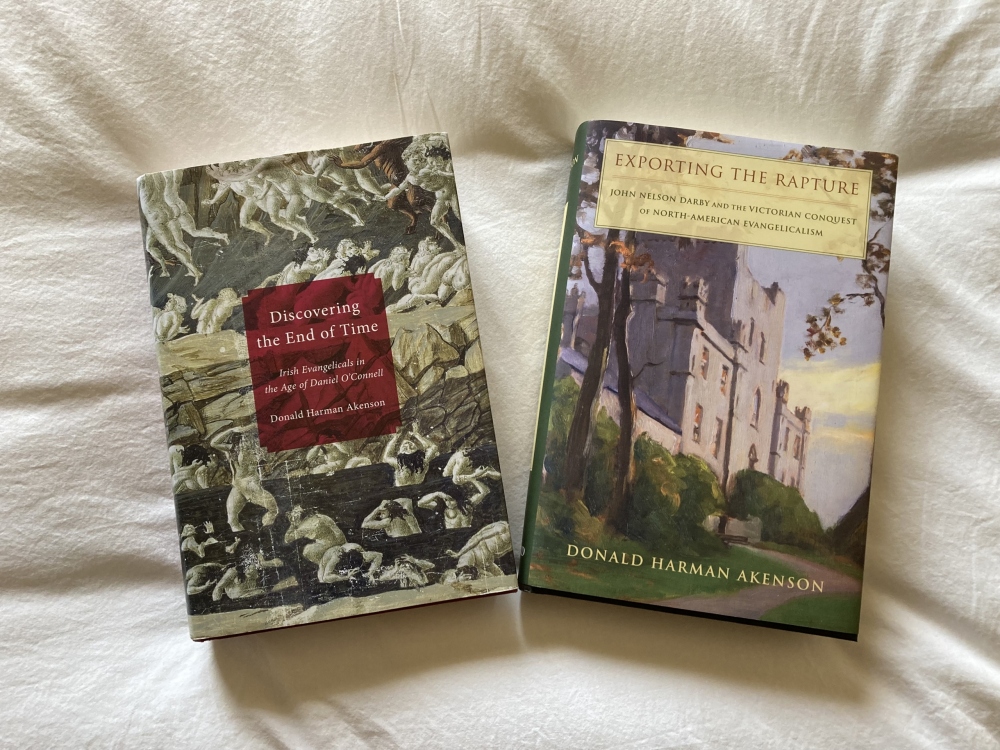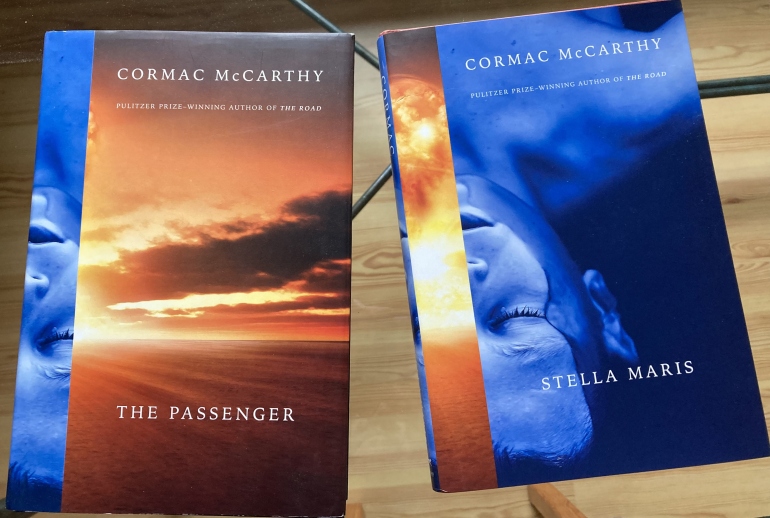The two books I am mentioning here fit together to tell one continuous story. They should be read in the order they were published. But not by everybody. They will not be of interest to every reader, nor should they. Both are dense and scholarly, written by a professional historian who takes his craft seriously, are meticulously footnoted (some footnotes are a page or more in length), and are detailed in a way that academics and non-academics like me love but general readers find simply too much to bear—my wife’s term is “insufferable.” I understand if you choose not to read them. So will Margie.
The first volume, Discovering the End of Time, provides background on evangelical belief in the Church of Ireland (it was vibrant and alive) in the 19th century; on John Nelson Darby’s life and ministry as an ordained clergyman in the Church of Ireland (he was in a diocese under a solidly evangelical bishop and in close fellowship with wealthy evangelical supporters); and the early development of Darby’s novel doctrines (beliefs that had been lost, in his reckoning, after the apostles died).
The second volume, Exporting the Rapture, tells how Darby intentionally shaped (by tireless preaching, writing and publishing, repeated church splits, shunning, and excommunication, personal relationships and communication) the Exclusive Brethren, a small movement in one province in Ireland, splitting it off from the Open Brethren as his own ecclesiastical fiefdom. He ruled it with an iron fist, believing that no doctrine or practice other than his own, was correct. Though he often had no or only disputed biblical support for his ideas, he was certain he was being led by the Holy Spirit and that was, in his mind, sufficient. The historical irony is that the Brethren movement was small and intentionally isolated, yet Darby’s doctrines shaped the beliefs of American fundamentalism and evangelicalism even though few on this side of the Atlantic had ever heard of Darby.
I was drawn to Akenson’s two books for two reasons. First, I am interested in learning the history of White American evangelicalism in order to try to gain a better understanding of it, including why it is in such tatters today. And I am interested in learning the early history of the “Christian Brethren” or “Plymouth Brethren”—the movement Darby helped launch—because I was raised in those circles.
The author is Donald Harman Akenson, a prolific historian and the Douglas Professor of Canadian and Colonial History, Queens University, Ontario. He wrote these two books, Akenson says…
…to contribute to our understanding of a big, holy mystery: How was it that a set of ideas and practices that were virtually unknown in the early nineteenth century become by the mid-twentieth century so dominant among North-American evangelicals that they are taken as having been embraced forever, part of the primordial truth of Christianity? These consisted of a radically democratic view of acceptable ecclesiastic structure (an ecclesiology that was not entirely novel, being Protestantism at its European extreme); a brand-new way of reading the Jewish and Christian scriptures (a novel hermeneutic); and a previously unknown interpretation of prophecy and of the end of human time (a shimmeringly new eschatology). [Exporting, p. 290]
Well researched and clearly written, Discovering and Exporting are scholarly without being inaccessible to the serious, ordinary reader. Though Akenson lost me repeatedly while tracing the family links of the various aristocratic people who supported Darby, the main trajectory of the story is clearly communicated.
Central to the difficulty of comprehending and writing this early history of Darby, his novel doctrines, and the Brethren movement is the Brethren’s refusal to keep accurate written records. Since the Rapture is expected at any moment since the world is going from bad to worse and the church since the apostolic age has been in ruins and beyond repair, what is the point? This reluctance included and followed the example of Darby himself. So, the historical record is both very sparce and at times, evidently incorrect.
It is clear that in his late maturity Darby settled on an interpretation of his own life that used apocalyptic thinking as its template. In his sixties and seventies, he rewrote the hesitations and anxieties and bothersome medievalisms of a young cleric who had tried to fight against his archbishop by printing an anonymous pamphlet, and he turned those haverings into a near-apocalyptic story. Archbishop William Magee became a powerful demon whose actions lost for all eternity thousands and thousands of souls, and John Nelson Darby heroically stood against evil; though he lost the immediate battle, he had begun the “Church of God” and that Church was bound for eventual eternal victory. In the long view, Darby’s ability to create facts, ignore reality, and to establish a coherent narrative that transcends mere accuracy was a prerequisite for his performance in his maturity in the role of a full-fledged religious genius, a prophet who broke free of the present world and established an alternative universe. [Discovering, p. 253]
Sadly, those who need Discovering and Exporting most will probably not read them. Members of the movement who read them will not necessarily walk away (nor need they do so), but it will help them identify where the biblical underpinnings of Brethren distinctiveness need to be fortified. At its best, the Plymouth Brethren produced the biblical scholar F. F. Bruce; C. Stacy Woods and Paul Little of InterVarsity Christian Fellowship; and theologian James Houston who was instrumental in beginning Regent College (Vancouver). Because the Assemblies have no clergy, it has also encouraged serious Bible reading and study among it’s laypeople.
Though the split between Exclusive and Open remains to this day, the beliefs and patterns of behavior tend to be on a spectrum that occasionally bleeds across the divide. At it’s worse, the movement results in numerous autonomous Assemblies that are proudly exclusive, inward-looking groups that hold firmly to a sacred / secular dichotomy; use shunning, schism, and excommunication to maintain purity; insist on separatism from the “world” including friendships with non-Christians and art and culture; provide constant reminders that it is the true church and all others are in ruins and beyond hope; as well as a belief in a secret Rapture that undermines caring for the earth that belongs to the Lord. In my personal experience, the most damaging aspect of my Brethren experience was the insistence that my honest questions about what we believed and why were actually the product of a rebellious heart full of unconfessed sin.
I am deeply grateful for aspects of my Brethren background: a firm belief in Scripture, the model of faith missions, and a knowledge of the Bible, for example. And Akenson granted me new insight into why and how the structure and practice of Brethren Assemblies makes it so difficult and profoundly painful to leave the movement. As my father reminded me repeatedly, I did not leave for another church, rather I was putting myself “out of fellowship,” a dreaded spiritual condition that clearly implied not just out of fellowship with the true church, but out of fellowship with God. Even when I stopped believing such sectarian nonsense, his comments hurt, and that belief, repeated so often, represented emotional shackles that were difficult to break. Over the years I’ve seen examples of shunning in action even in Open Assemblies. It is a terrible fate. It can range from relatively mild to severe, and can fracture families, sending some away from faith and the church with great bitterness.
On the other hand, Akenson argues that given the historical record, the story of John Nelson Darby is very amazing. He is correct. Darby was a difficult and hard man, certain that whatever he taught was the final word on the matter superintended by the Holy Spirit. But he was also an original thinker and effective leader. Consider: how could a young curate of the Church of Ireland in a remote corner of rural Ireland develop new theological ideas that beginning in his lifetime not only launched a new church movement but went on the influence the doctrinal underpinnings of the fundamentalist and evangelical movements in North America? Akenson puts it this way:
It is possible to trace in a very tight causal ladder the Darbyite mode of reading the Bible through the seminal figures of some of the major strands of nineteenth- through twenty-first-century evangelicalism: those represented by Dwight L. Moody, William Bell Riley, and Billy Graham, however quietly each of these figures recognized his debt… One of the main points of this study is that in a brief and singular period historical events in Ireland and the personalities of keen biblical students met in a fashion that should be recognized as one of the formative causal intersections in the evolution of modern Christianity as a world religion. [Discovering, p. 6-7, 8]
Few religious leaders leading sectarian movements have such influence. It’s a story worth reading.
Books recommended:
Discovering the End of Time: Irish Evangelicals in the Age of Daniel O’Connell by Donald Harman Akenson (McGill-Queen’s University Press; 2016) 486 pages + bibliography + index.
Exporting the Rapture: John Nelson Darby and the Victorian Conquest of North-American Evangelicalism by Donald Harman Akenson (Oxford University Press; 2018) 438 pages + appendix + bibliography + index.
Photo credit: the author with his iPhone.



